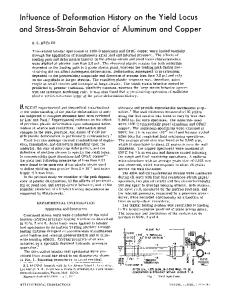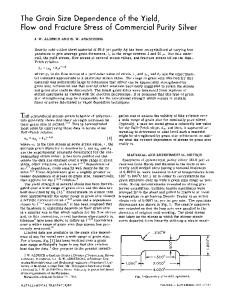Investigation of Specimen- and Grain-Size Dependence of Yield Stress in Electrodeposited Nanocrystalline Copper through
- PDF / 3,466,031 Bytes
- 6 Pages / 612 x 792 pts (letter) Page_size
- 121 Downloads / 381 Views
Investigation of Specimen- and Grain-Size Dependence of Yield Stress in Electrodeposited Nanocrystalline Copper through Micropillar Compression Norihiko L. Okamoto, Daisuke Kashioka and Haruyuki Inui Department of Materials Science and Engineering, Kyoto University, Sakyo-ku, Kyoto 606-8501, Japan
ABSTRACT The specimen-size dependence of yield stress of nanocrystalline copper with average grain size (d) of 360 nm has been investigated through uniaxial compression tests of micrometersize pillars fabricated via the focused ion beam method. The yield stress decreases with the decrease in the micropillar size while the yield stress is almost constant for larger micropillars. The critical specimen size (t) is approximately 12.5 μm, correspoinding to the critical (t/d) value, (t/d)*, of 35, which is much larger than that for coarse-grained copper polycrystals. INTRODUCTION In coarse-grained polycrystalline metals, plastic deformation occurs via glide of lattice dislocations and their interaction with grain boundaries (GBs). In order to ensure the continuity in strain at GBs, grains exercise a mutual constraint on one another during deformation (figure 1(a)). This mutual constraining interaction among grains requires multiple slip to operate, having a large influence on the mechanical properties. Many experiments have shown that flow stresses for thin films of coarse-grained polycrystalline metals with grain size d, decrease with decreasing film thickness (t) when the number of grains contained along the thickness direction becomes smaller than a critical value, (t/d)* [1-4]. This “thinner is weaker” trend indicates that the range of the mutual constraining interaction is finite. As shown in figure 1(b), the critical value (t/d)* has been reported to increase with decreasing grain size for pure copper thin films [4]. Since the grain size in these experiments was large enough (16−140 μm), the dominant mechanism of the plastic deformation is considered to be dislocation slip motion. Then, a question arises as to how the mechanical properties change depending on the specimen size when the grain size is so small that the deformation mechanism based on dislocation slip is no longer operative. In the present study, we examined the grain-size dependence of electrodeposited nanocrystalline copper with the grain size of 360 nm to determine the critical value (t/d)* in nanocrystalline metals through uniaxial compression tests of micrometer-size pillars fabricated via the focused ion beam (FIB) method.
Figure 1. (a) Schematics of mutual constraining interaction among grains during deformation of thin metal films. (b) Relationship between the critical value (t/d)* and grain size for coarsegrained pure copper [4].
EXPERIMENTAL PROCEDURES Nanocrystalline copper films of 300 μm thickness were prepared by pulsed electrodeposition. The bath composition was 0.72 mol/L copper sulfate (CuSO4-5H2O), 1.3 mol/L sulfuric acid (H2SO4), and 5 mg/L gelatin. The gelatin was added in order to maintain the flatness of the deposition surface. Strips
Data Loading...











